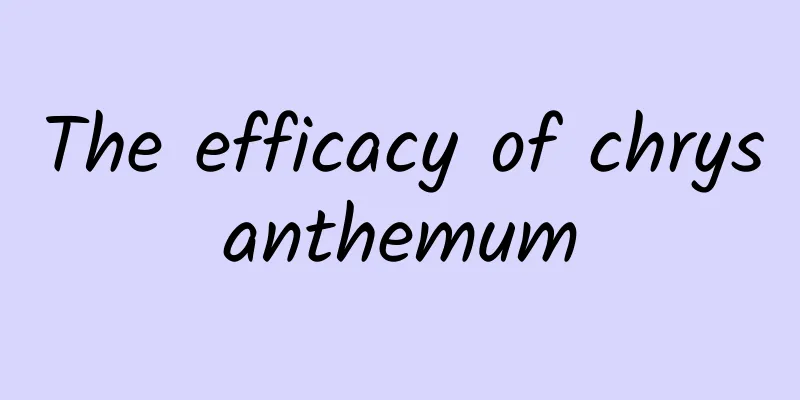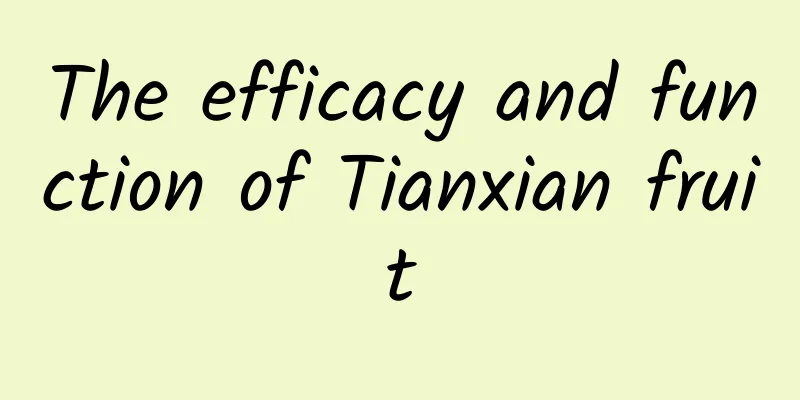The efficacy of chrysanthemum

|
When it comes to potted flowers such as chrysanthemum, I believe many people's first impression is that they are very beautiful and highly ornamental. In fact, chrysanthemum is a famous chrysanthemum used for tea in my country, and it has a long history. As early as in ancient times, this kind of tea was only consumed by the royal family and was an ancient offering. The effects and functions of chrysanthemum are very good. It has the effects of clearing the eyes, relieving inflammation, and strengthening the physical fitness. It has a very good health care and medical effect on some minor problems and pains. So what else does chrysanthemum have? The functions and effects of chrysanthemum are very numerous and good. It is said that using chrysanthemum as a nourishing soup for bathing has the effects of relieving itching, refreshing the body, beautifying the skin, etc. Especially in the hot summer, drinking a pot of chrysanthemum tea has the effects of clearing away heat and fire, and clearing the eyes. Below I will explain in detail the functions and effects of chrysanthemum. The function of Hangbai Chrysanthemum White chrysanthemum, also known as Xiaotanghuang and Xiaobaiju, is a native product of Tongxiang. It, along with Chuju and Boju from Anhui Province and Huaiju from Henan Province, are all famous chrysanthemums used for tea in my country. Chrysanthemum has a long history of cultivation in my country. "Hangzhou Bai Gongju" has always been mentioned together with "Longjing Tea". It was used as an offering in ancient times. Efficacy and functions of Poria cocos: pungent, sweet, bitter, and produces cold. Function: Fire-fighting and evacuating wind-cold and wind-heat, soothing the liver and clearing the eyes, clearing away heat and removing fire. Yellow chrysanthemum has a stronger effect in fire evacuation and purgation, while white chrysanthemum can also protect the liver. It is commonly used in the treatment of exogenous wind-heat or the initial stage of febrile disease, as well as hyperactivity of liver yang, liver-fire eye diseases, heat-toxic sores and swellings, etc. Chrysanthemum, also known as chamomile, is a traditional Chinese medicinal plant. It is one of the eight famous Chinese medicinal materials in Zhejiang, “Zhe Eight Flavors”, and is also the best variety of chrysanthemum tea. Modern medicine has confirmed that it has the effects of stopping diarrhea, reducing inflammation, clearing eyesight, lowering blood pressure, lowering blood lipids, and strengthening the body. It can be used to treat cold and damp jaundice, stomach pain, indigestion, edema and oliguria. Taking a shower with chrysanthemum soup can relieve itching, refresh the body, and beautify the skin. Also known as Xiaotanghuang and Xiaobaiju, it is a local specialty of Hangzhou. It, along with Chuju and Boju from Anhui Province and Huaiju from Henan Province, are all famous chrysanthemums used for tea in China. Chrysanthemum has a long history of cultivation in China. "Hangzhou Bai Gongju" has always been mentioned together with "Longjing Tea". It was used as an offering in ancient times. It is made from fresh white chrysanthemum, a perennial woody plant, which is steamed and dried. After being mixed with boiling water, the water turns light green and is full of fragrance. Hangzhou chrysanthemum contains chrysanthemum sugar, amino acids and a small amount of vitamins, which have the effects of dispelling heat, clearing eyes and removing toxins. It also has the effects of relieving heat and reducing fever, clearing away heat and fire, refreshing the mind and promoting diuresis. The types of chrysanthemum include lake chrysanthemum, small foreign chrysanthemum, large sea chrysanthemum, small white chrysanthemum, small lake yellow, etc. The origin of Hangzhou chrysanthemum is in Tongxiang, which has a long history of cultivation, a large planting area, high production volume and good quality. In the past, in order to take advantage of the fame of Hangzhou, the Tongxiang Tea Company named the white chrysanthemum produced in Tongxiang as "Hangzhou", and the name is still used today. According to the traditional customs of Zhejiang Province, "yellow chrysanthemum is used as medicine, white chrysanthemum is used as tea", and yellow chrysanthemum is listed as one of the eight major Chinese medicinal materials in Zhejiang Province. According to medical analysis, chrysanthemum contains ingredients such as chrysanthemum, honey, amino acids and a small amount of vitamins. It is cold in nature and tastes bitter and sweet. It has the effects of dispersing wind, clearing heat and detoxifying, clearing away heat and fire, and removing toxins and reducing inflammation. It can treat hypertension, migraine, subacute conjunctivitis and other symptoms. If you use chrysanthemum to make tea as a drink, it is slightly sweet and fragrant, and is also a top-grade product. Efficacy and effects: Ingredients and functions: Chrysanthemum is a green plant of the Asteraceae family. Its flowers contain 0.13% volatile oil, chrysanthemum glycoside, adenine, cholecalciferol, stachydrine and a small amount of vitamin D-like substances, vitamin B2, carbohydrates and acacia alkaloids. Mutual research between traditional Chinese medicine and Western medicine of the Chinese nation has shown that drinking chrysanthemum tea has the following effects: 1. It has a calming effect on the nervous center; 2. It has an antipyretic effect; 3. It improves capillary resistance and expands coronary artery function; 4. It has an antibacterial effect. Chrysanthemum decoction and infusion have inhibitory effects on Staphylococcus aureus, Shigella dysenteriae, Proteus, Salmonella typhi, Salmonella paratyphi, Vibrio cholerae, Hepatitis B hemolytic Streptococcus, Escherichia coli, Pseudomonas aeruginosa, Homo tuberculosis and influenza virus (PR3 strain). Element composition of chrysanthemum: chrysanthemum contains iron, sodium, iron and other elements, especially iron, which is the largest component. Iron is a key component of body cells. More than half of the enzymes in the tricarboxylic acid cycle contain iron or require iron as a second messenger. Iron is closely related to the body's immune defense function. It can coordinate the metabolism of zinc, calcium, and magnesium. Chrysanthemum contains more nickel, zinc and iron, while wild chrysanthemum has higher sodium and calcium than chrysanthemum. The biggest difference is that the lead content in wild chrysanthemum is 6 times that of chrysanthemum, which is related to the ecological environment in which they grow and develop, and also warns us humans of the adverse effects of environmental lead pollution. Because the lead content of chrysanthemum is low and it contains high mineral content, it has high therapeutic and health value. Milk tea: The chrysanthemum produced is made from pure natural technology and the roses are dried to make a healthy drink that can be boiled for tea. It has natural characteristics. Function: Clears away heat and reduces internal fire, soothes the liver and clears eyes, loses weight and beautifies. Preparation method: 1. Take about 3-4 chrysanthemums and put them into a 400ml glass cup; 2. Add boiling water (100 degrees) about 70% to 80% full, cover with a lid, steep for 3-5 minutes, and drink it while it is hot; 3. Drink until 1/3 of the soup is left, then add boiling water to make the soup more evenly concentrated; 4. You can add sugar or honey, or add any kind of tea you like, such as French rose, wolfberry, etc. After reading the above introduction to the functions and effects of chrysanthemum, I believe that everyone has a certain understanding and knowledge of chrysanthemum. Chrysanthemum is a kind of tea with high health value and good naturalness. Drinking it regularly can help you lose weight, beautify your body, and clear away heat and reduce internal heat. In addition, remember to use boiling water when brewing, and you can also add some honey and rose, etc., so that the taste will be more rich and fragrant! |
Recommend
The efficacy and function of fern pods
There are so many medicinal herbs in the world, a...
Who is the fattest bear this year? It's this one, one bear is worth two bears! | Nature Trumpet
Welcome to the 19th issue of the Nature Trumpet c...
The little secret of the park: making the city "alive"
Biodiversity Conservation From the Wild to the Ci...
Why is sepsis so likely to kill people? Six facts you must know
Speaking of "sepsis", you may feel unfa...
When adults start to like stuffed toys, is it childish or is it because they still have a childlike innocence?
Leviathan Press: Is it escapism and immaturity to...
Scary! Vegetables tied with tape are toxic, with formaldehyde exceeding the standard by 10 times?
Expert of this article: Huang Shan, Deputy Direct...
The efficacy and function of wool ball crab
Wool ball crab is a common type of traditional Ch...
The efficacy and function of Artemisia selengensis
Artemisia selengensis has rich nutritional value ...
The efficacy and function of water mahogany flower
Water rosewood flower is a kind of Chinese herbal...
How powerful is the first-class carcinogen that infects half of the Chinese people? Do these 3 things to prevent it
Oops, I had a test today and it said I’m positive...
What is the effect of Tianma?
What exactly does Gastrodia elata do? Many people...
Why is immunity the "weapon" to defeat the virus? 4 simple and effective ways to enhance immunity
Speaking of immunity Everyone knows If your immun...
The black box has been found! All aircraft are required to install it. What important information can it provide?
The crash of China Eastern Airlines flight MU5735...
The sixth day of the Lunar New Year is the beginning of spring, welcoming the new year with spring in the air
In the long river of time, the encounter between ...
What are the effects and functions of Codonopsis pilosula
Codonopsis pilosula is a nutritious product that ...









